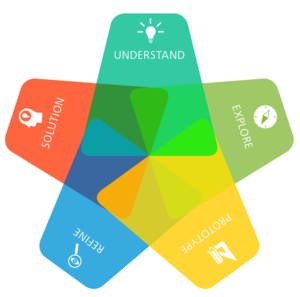Hands-on with Design Thinking: Explore Phase
This article is part of a series. Explore is #2 of 5.
In this series, Michele Ronsen of Ronsen Consulting explores Design Thinking through blogs and activities. Before reading the article below, check out the first blog in the series, which covers the Understand phase of Design Thinking.
The design industry has gone through significant changes in roles and responsibilities over the past ten years. If you’ve been in the industry as an educator; it’s obvious. As a student, it may not be yet. The world is smaller than it was before, and technology and globalization have played a key role in bringing experiences to our hands. We as designers today have become more cross-functional in our scope, and expectations are high for the products and experiences we deliver. Design thinking has become a necessary piece of our process if we are to drive sustainable and positive change socially, economically, and behaviorally.
This blog series covers the five steps of Autodesk’s User-Centered Design and Design Thinking process for educators and practitioners—Understand, Explore, Prototype, Refine, and Solve—and includes several homework assignments for hands-on practice.
In our last post, we covered Understanding and learned how to implement practices of empathy in order to uncover and grasp people’s wants and needs. This foundational step sets the tone for our design process and ensures that we’re designing for impact.
Our next step is to Explore. In this phase, we will take a look at how we approach potential design solutions. We need to go wide on explorations before we select directions to Prototype, which is a form of validating and testing. In the following posts, we will look at Refining directions so that we can ultimately arrive at a Solution for people’s needs.
Let’s zero in on Exploring, another key step to success.
This phase is about finding solutions to the problems we’ve uncovered. The goal here is to generate a wide range of ideas on how we might meet the needs of the people for whom we’re designing. Much like the approach to Understand, there are both active and passive methods we might employ.
Active, or primary, exploration is the direct application and expansion of one’s own ideas. Common active exercises include brainstorming (which could either be independent or collaborative), mind mapping, or soliciting ideas from others through interviews, surveys, intercepts, or other means. These can be done on your own or with your team, stakeholders, or people representing the users of your product or service.
For example, if you have come to the understanding that a major problem for people using a fitness center is dis- comfort, you might use a mind map to explore all the possible triggers for this. You might start with “gym dis- comfort” written at the center and branch into categories like facility layout, understanding of equipment, types of classes offered, internal dissatisfaction with self or progress, environmental factors like temperature and noise, or preconceived stigmas. With each branch, you can dive deeper into more specific variables that might be angling on the discomfort that causes people to avoid working out.
Passive, or secondary exploration methods include finding ideas others have already identified. These are usually done individually and can be found by searching online forums, published articles, interviews, and theses. There’s also always the possibility that someone has already conducted research on the topic that you are exploring; go out and find that. It’s worth mentioning that while your favorite search engine is your friend, do be sure to authenticate what you’ve found online.
Here are four suggestions on how to explore and generate a wide range of ideas successfully.
First, identify your biases, and sideline them! By objectively exploring a given landscape, you will come up with a larger range of ideas and potentially better solutions than if you limit yourself.
Second, identify your assumptions and challenge them. Then challenge them again. It’s really easy to go with your instincts, and they can indeed be good starting points. However, unless you are a full representation of your audience, you need to get perspective beyond your own. Question what you believe to be true; it may not be in the given scenario.
Third, work quickly. The goal of generating ideas should never be to develop perfect solutions. The goal is to identify a range of initial thoughts and convey them clearly enough to demonstrate the intent. A common practice for brainstorming is to use sticky notes to document ideas. Each note is just enough space for a single word or sentence, which is just enough to quickly express and impress a thought.
Fourth, there are no bad ideas! You may discount something, but remember to remove your biases and assumptions. Even the smallest or silliest of ideas may have merit. Give yourself and others permission to generate; creating an open environment always generates a larger quantity of ideas and better quality ones than a closed off one.
Okay, so we’ve got active and passive methods of exploration, and we know we need to identify our biases, challenge our assumptions, and work quickly. Can we push this any further?
Consider some of the following to layer onto your process:
Take something that already exists and change it incrementally.
Combine an existing idea with a new one.
Combine multiple ideas into buckets that are a new idea.
Turn the problem on its head; approach it from an entirely new perspective.
Throw all practicality and constraints out the window.
Follow the path of the least resistance.
Identify small, iterative ideas that eventually meet the need over time.
Personally, I work both individually and with others to identify ideas, flesh them out, and identify the best con- tenders to move forward. Other people have valuable perspectives; whenever possible seek out their input. Sometimes just the exercise of talking through a concept with another person can be helpful in gauging if the concept is palpable or too ambiguous. Looking out for initial reactions and interpretations is not only helpful validation on an idea, but can sometimes lead to new ideas.
Again, always build in time to analyze and synthesize the ideas generated in this step of design thinking. Look for patterns and themes. Take a step back and look again. Be cautious of outliers. Look for obvious holes. Fully processed ideas will fare better in the next steps of the design thinking process.
Don't underestimate the importance of Exploring. Not developing a wide range of ideas, or including various perspectives could lead to big missed opportunities.
Now, let’s try it out.
Here are some exercises that will help you refine skills of Exploring. This assignment, together with the Autodesk Design Academy Help the Environment—Animated PSA project, will help you integrate design thinking as a framework that can be applied to any project. Animator Warren Fearn will walk you through his design process.
Use the assignment exercises to explore your design and get connected to a design community by posting and sharing your progress along the way.







